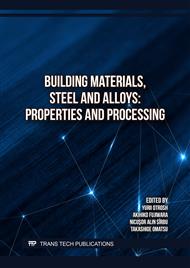p.59
p.65
p.71
p.79
p.91
p.101
p.109
p.125
p.131
Analysis of Mechanical Strength in Concrete Specimens with Inclusion of Recycled Glass in Peru
Abstract:
In recent years, interest in incorporating recycled materials in the construction industry has grown significantly, driven by the urgent need to mitigate the environmental impact that this activity generates on a daily basis. This interest is not only due to the growing awareness of environmental preservation, but also to the sustainability requirements imposed by international and national regulations [1]. The inclusion of recycled materials has piqued the interest of several researchers. Recycled glass, due to its particular characteristics, has been the subject of numerous studies in the field of construction. Research has shown that incorporating crushed glass into mortar and concrete mixtures can improve certain mechanical properties [2], such as compressive strength and thermal conductivity, as well as significantly reduce the amount of solid waste that is deposited in landfills [3]. These findings highlight the importance of investigating with precision and scientific rigor the effects of recycled glass on concrete performance [4]. In Peru, the need to promote sustainable construction practices has encouraged research on the use of recycled glass in the production of concrete. This research focuses on evaluating, through controlled tests and scientific methods, how the inclusion of recycled glass can influence the mechanical properties of concrete, especially its compressive and tensile strength. The systematic evaluation of these factors will allow us to identify if this technique is viable for implementation in the construction sector, and if it can meet the sustainability criteria established in the Peruvian context [5].
Info:
Periodical:
Pages:
125-130
Citation:
Online since:
October 2025
Authors:
Price:
Сopyright:
© 2025 Trans Tech Publications Ltd. All Rights Reserved
Share:
Citation:


